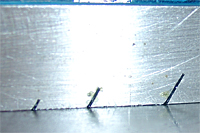EDM
Electro-Discharge Machining
EDM – Electro-Discharge Machining – is a method of machining metals. It is sometimes called ‘spark erosion’ because the metal is removed by electrical discharge between an electrode and the work-piece. Hence EDM only works with materials that are electrically conductive. The removed material is taken away by a continuously flowing fluid. EDM is used for hard metals and is commonly used for cutting intricate contours or fine cavities which would be difficult to produce by other cutting tools. In NDT it is used to produce ‘EDM notches’, otherwise referred to as ‘spark eroded slots’. These notches are placed in testpieces so that the detection and sizing capability of NDT procedures can be assessed. In ultrasonics the EDM notch represents a smooth planar defect. The Figure shows a test-piece containing three EDM notches of various depths.

The advantages of using EDM notches as target defects are:
For more information on the design of test-pieces see:
ENIQ Recommended Practice 5: Guidelines For The Design Of Test-Pieces And Conduct Of Test-Piece Trials Issue 1 which can be obtained from:
http://capture.jrc.ec.europa.eu/capture/sites/capture/files/files/documents/eur18686en.pdf
What the hec?! articles are not intended to be the definitive account on the topic or acronym in question. Readers’ comments and contributions are welcomed. Email: ndtnews@bindt.org

The advantages of using EDM notches as target defects are:
- the position and dimensions of the EDM notch are known;
- the insertion of the EDM notches is simpler, more cost efficient and less time consuming than manufacturing defects by fatigue or corrosion mechanisms;
- the material surrounding the defect is left in the original state.
For more information on the design of test-pieces see:
ENIQ Recommended Practice 5: Guidelines For The Design Of Test-Pieces And Conduct Of Test-Piece Trials Issue 1 which can be obtained from:
http://capture.jrc.ec.europa.eu/capture/sites/capture/files/files/documents/eur18686en.pdf
What the hec?! articles are not intended to be the definitive account on the topic or acronym in question. Readers’ comments and contributions are welcomed. Email: ndtnews@bindt.org